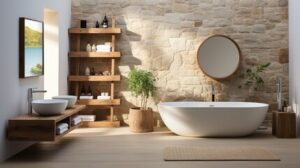A roofing company plays a crucial role in the construction and maintenance of buildings, ensuring that properties remain structurally sound and protected from the elements. The roof is one of the most critical components of any building, serving as the first line of defense against weather conditions such as rain, wind, snow, and extreme heat.

A well-constructed and properly maintained roof not only protects the building’s occupants but also preserves the integrity of the structure and enhances its overall value. Roofing companies provide a wide range of services, including roof installation, repair, replacement, and maintenance. Their expertise ensures that roofs are built to withstand environmental pressures while maintaining functionality and aesthetic appeal. Read on Roofing Company Near Me for more information.
Roofing companies begin their work by conducting a thorough assessment of the property and the existing roof structure. This initial inspection allows them to identify potential issues such as leaks, damaged shingles, weak spots, and improper drainage. A detailed evaluation helps the roofing company determine the most effective course of action, whether it involves minor repairs, a full roof replacement, or preventative maintenance. By understanding the unique characteristics of the building and its environment, roofing companies can recommend materials and designs that provide the best combination of durability, energy efficiency, and visual appeal.
The installation of a new roof is a complex and labor-intensive process that requires skilled professionals and specialized equipment. Roofing companies work closely with property owners to select the appropriate materials based on factors such as climate, budget, and architectural style. The choice of roofing materials can significantly impact the performance and longevity of the roof. Common materials include asphalt shingles, metal roofing, clay tiles, and wood shakes, each with distinct advantages and maintenance requirements. Roofing companies ensure that the installation process is carried out with precision, adhering to industry standards and local building codes. Proper installation is essential to prevent future problems such as water infiltration, poor ventilation, and structural damage.
Roof repairs are another essential service provided by roofing companies. Over time, exposure to harsh weather conditions, UV radiation, and natural wear and tear can cause roofs to deteriorate. Roofing companies are equipped to handle a wide range of repair issues, from replacing damaged shingles and sealing leaks to reinforcing weak spots and improving drainage systems. Prompt repairs are crucial in preventing minor issues from escalating into costly structural damage. Experienced roofing professionals can quickly diagnose the source of a problem and implement effective solutions that restore the roof’s integrity and performance.
Roof replacement is sometimes necessary when the existing roof has reached the end of its lifespan or sustained extensive damage. A roofing company will carefully remove the old roofing materials, inspect the underlying structure for damage, and prepare the surface for new installation. The replacement process involves not only installing new materials but also improving the roof’s overall design and performance. This may include adding insulation, improving ventilation, and installing modern weather-resistant materials. A professionally installed replacement roof enhances the property’s energy efficiency, reduces maintenance costs, and increases its market value.
Preventative maintenance is a key aspect of a roofing company’s services. Regular inspections and maintenance help extend the lifespan of a roof and minimize the risk of unexpected problems. Roofing companies offer maintenance plans that include cleaning debris, checking for loose or damaged materials, inspecting flashing and gutters, and assessing the roof’s overall condition. Preventative maintenance allows property owners to address minor issues before they develop into major concerns, reducing repair costs and preserving the roof’s performance.
In addition to technical expertise, roofing companies provide valuable guidance on improving energy efficiency and environmental sustainability. Modern roofing materials and technologies are designed to enhance insulation, reduce heat absorption, and improve overall energy performance. Roofing companies can recommend and install reflective roofing materials, green roofing systems, and solar panels to help property owners reduce their energy consumption and lower utility costs. Environmentally friendly roofing solutions not only benefit the property owner but also contribute to broader efforts to reduce environmental impact and promote sustainable construction practices.
A roofing company’s role extends beyond installation and repair to include emergency response services. Severe weather events, such as storms and heavy winds, can cause sudden and extensive damage to roofs. Roofing companies offer emergency repair services to quickly address issues such as water infiltration, structural damage, and missing shingles. Timely response is essential in preventing further damage to the property and ensuring the safety of its occupants. Emergency roofing services often involve temporary repairs to stabilize the roof, followed by more comprehensive solutions once weather conditions improve.
Customer service and communication are integral to the success of a roofing company. Professional roofing companies prioritize clear and transparent communication with their clients throughout the entire project. This includes providing detailed estimates, explaining the scope of work, and addressing any concerns or questions that may arise. A reliable roofing company ensures that clients are informed and confident in the decisions being made about their property. Effective communication fosters trust and helps establish long-term relationships between roofing companies and their clients.
Safety is a top priority for roofing companies, given the inherent risks associated with working at heights and handling heavy materials. Roofing companies implement strict safety protocols and provide ongoing training for their workers to minimize the risk of accidents and injuries. Proper use of safety harnesses, scaffolding, and protective equipment is essential to ensuring a safe working environment. Roofing companies also carry liability insurance and workers’ compensation coverage to protect both their employees and clients in the event of an accident. Adhering to safety standards not only protects workers but also ensures that projects are completed efficiently and without disruptions.
The expertise of a roofing company extends to working with various architectural styles and complex roof designs. Historic buildings, modern structures, and custom homes each present unique challenges that require specialized knowledge and techniques. Roofing companies have the experience and resources to handle complex roofing projects, including steep slopes, multiple roof levels, and intricate detailing. Their ability to adapt to different architectural requirements ensures that the final result complements the building’s overall design and meets the client’s aesthetic preferences.
Insurance claims and warranty management are also part of the services provided by roofing companies. In the event of damage caused by natural disasters or accidents, roofing companies assist property owners in navigating the insurance claims process. They provide detailed documentation of the damage, work directly with insurance adjusters, and ensure that repairs or replacements are covered under the terms of the policy. Roofing companies also offer warranties on their workmanship and materials, giving clients peace of mind that their investment is protected. A comprehensive warranty reflects the company’s confidence in the quality of their work and reinforces client trust.
The success of a roofing company depends on its ability to deliver high-quality workmanship, maintain strong client relationships, and adapt to changing market demands. Advances in roofing technology, such as improved materials and installation methods, allow roofing companies to provide more efficient and durable solutions. Staying informed about industry trends and best practices enables roofing companies to offer innovative products and services that meet the evolving needs of their clients. A commitment to continuous improvement and customer satisfaction sets a reputable roofing company apart from its competitors.
Ultimately, a roofing company serves as a trusted partner in protecting and enhancing the value of a property. Their expertise in installation, repair, maintenance, and design ensures that roofs are not only functional but also visually appealing and energy-efficient. A well-maintained roof contributes to the overall comfort and safety of a building, reducing long-term maintenance costs and increasing property value. The professionalism, reliability, and skill of a roofing company have a lasting impact on the structural integrity and aesthetic quality of a property, making them an indispensable part of the construction and maintenance industry.



